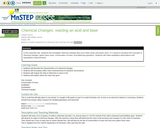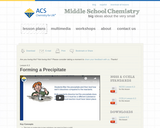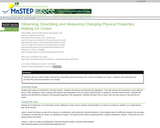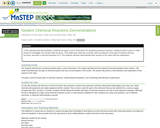
In this activity, students use coins to model molecules and demonstrate how mass in conserved in a chemical reaction.
- Subject:
- Science
- Material Type:
- Activity/Lab
- Provider:
- Exploratorium
- Date Added:
- 10/02/2017

In this activity, students use coins to model molecules and demonstrate how mass in conserved in a chemical reaction.

CK-12 Physical Science Concepts covers the study of physical science for middle school students. The 5 chapters provide an introduction to physical science, matter, states of matter, chemical interactions and bonds, chemical reactions, motion and forces, and the types and characteristics of energy.

In this lab activity, students will investigate chemical changes that occur when acids and bases react. It is meant to introduce the concepts of chemical changes, mass of gases, conservation of mass, and balancing equations. Students will make qualitative observations and quantitative measurements.

This supplemental resource is to be used during the lesson "Chemistry 201: Physical and Chemical Properties and Changes." The data sheet will be used by students to record their data and observations during the associated lab activity. In this lab activity, students observe various changes in matter, massing the chemicals before and after the changes.

Students will do a hand-on experiment to create a precipiate and analyze chemical equations to see that all atoms in the reactants end up in the products.

In this problem set, learners will practice fractions by working with the ratios of various molecules or atoms in different compounds to answer a series of questions. Answer key is provided. This is part of Earth Math: A Brief Mathematical Guide to Earth Science and Climate Change.

This clever and inventive video lesson reviews the 5 major ways to speed up chemical reactions and presents them in a way to which students can easily relate. Discussion/assessment questions and suggested supplemental resources are also included.

Students will create an endothermic chemical reaction. Students will observe and describe the ingredients. They will measure the temperature of the milk and the ice. After making ice cream, students will measure the temperature of the ice cream (if thermometer is sanitized), and the ice/salt mixture. Students will observe and describe the changes in the physical properties of the ingredients. Students will taste the ice cream, and use their senses to describe the ice cream.

A complete introduction to scientific investigation and the scope of physical science. Includes: states of matter, atoms, periodic table, chemical bonding, chemical reactions, carbon chemistry, chemistry of solutions, nuclear chemistry, motion, forces, Newton's Laws of Motion, work and machines, energy, waves, sound, electromagnetic radiation, visible light, electricity, and magnetism.

In this lab activity, students are given a set of instructions for producing chemical reactions. Students work in pairs or small groups to investigate the reaction they are given. They determine what has occurred, what is produced, what type of reaction that has occurred, and write a chemical equation for it. The students will then demonstrate their reaction to the class with the explanation.

8th Grade Integrated Science textbook for the 2019-2020 school year. This textbook was developed to align to the Utah Science Core Curriculum. (Updated: May 29, 2019)